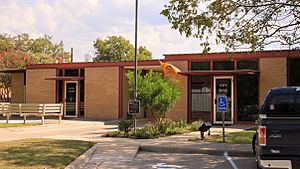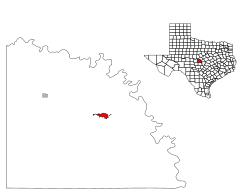San Saba, Texas facts for kids
Quick facts for kids
San Saba, Texas
|
|
|---|---|

San Saba City Hall
|
|
| Nickname(s):
Copper-9
|
|
| Motto(s):
"The Pecan Capital of the World"
|
|

Location of San Saba, Texas
|
|
 |
|
| Country | United States |
| State | Texas |
| County | San Saba |
| Area | |
| • Total | 2.71 sq mi (7.02 km2) |
| • Land | 2.71 sq mi (7.02 km2) |
| • Water | 0.00 sq mi (0.00 km2) |
| Elevation | 1,207 ft (368 m) |
| Population
(2020)
|
|
| • Total | 3,117 |
| • Density | 1,150.6/sq mi (444.3/km2) |
| Time zone | UTC-6 (Central (CST)) |
| • Summer (DST) | UTC-5 (CDT) |
| ZIP code |
76877
|
| Area code(s) | 325 |
| FIPS code | 48-65648 |
| GNIS feature ID | 2413254 |
| Website | City of San Saba, Texas |
San Saba is a city located in, and the county seat of, San Saba County, Texas, United States. It was settled in 1854 and named for its location on the San Saba River and for Sabbas the Sanctified. Its population was 3,099 at the 2010 census.
Contents
Geography
According to the United States Census Bureau, the city has a total area of 1.8 sq mi (4.7 km2), all land. The city is located 105 miles (169.0 km) northwest of Austin, and 141 miles (226.9 km) miles north of San Antonio.
Climate
The climate in this area is characterized by hot, humid summers and generally mild to cool winters. According to the Köppen climate classification, San Saba has a humid subtropical climate, Cfa on climate maps.
Demographics
| Historical population | |||
|---|---|---|---|
| Census | Pop. | %± | |
| 1860 | 111 | — | |
| 1870 | 168 | 51.4% | |
| 1880 | 598 | 256.0% | |
| 1890 | 697 | 16.6% | |
| 1920 | 2,011 | — | |
| 1930 | 2,240 | 11.4% | |
| 1940 | 2,927 | 30.7% | |
| 1950 | 3,400 | 16.2% | |
| 1960 | 2,728 | −19.8% | |
| 1970 | 2,555 | −6.3% | |
| 1980 | 2,850 | 11.5% | |
| 1990 | 2,626 | −7.9% | |
| 2000 | 2,637 | 0.4% | |
| 2010 | 3,099 | 17.5% | |
| 2020 | 3,117 | 0.6% | |
| U.S. Decennial Census | |||
2020 census
| Race | Number | Percentage |
|---|---|---|
| White (NH) | 1,517 | 48.67% |
| Black or African American (NH) | 98 | 3.14% |
| Native American or Alaska Native (NH) | 12 | 0.38% |
| Asian (NH) | 16 | 0.51% |
| Pacific Islander (NH) | 1 | 0.03% |
| Mixed/Multi-Racial (NH) | 57 | 1.83% |
| Hispanic or Latino | 1,416 | 45.43% |
| Total | 3,117 |
2020 census
The 2020 United States census counted 3,117 people, 1,021 households, and 666 families in San Saba. The population density was 1,150.6 per square mile (444.3/km2). There were 1,209 housing units at an average density of 446.3 per square mile (172.3/km2). The racial makeup was 63.36% (1,975) white or European American (48.67% non-Hispanic white), 3.53% (110) black or African-American, 0.58% (18) Native American or Alaska Native, 0.55% (17) Asian, 0.06% (2) Pacific Islander or Native Hawaiian, 20.44% (637) from other races, and 11.49% (358) from two or more races. Hispanic or Latino of any race was 45.43% (1,416) of the population.
Of the 1,021 households, 33.3% had children under the age of 18; 42.6% were married couples living together; 31.5% had a female householder with no spouse or partner present. 30.7% of households consisted of individuals and 15.9% had someone living alone who was 65 years of age or older. The average household size was 2.5 and the average family size was 3.2. The percent of those with a bachelor's degree or higher was estimated to be 6.0% of the population.
22.2% of the population was under the age of 18, 9.0% from 18 to 24, 31.2% from 25 to 44, 21.3% from 45 to 64, and 16.3% who were 65 years of age or older. The median age was 35.3 years. For every 100 females, there were 151.6 males. For every 100 females ages 18 and older, there were 172.0 males.
The 2016-2020 5-year American Community Survey estimates show that the median household income was $31,181 (with a margin of error of +/- $5,672) and the median family income was $40,083 (+/- $10,742). Males had a median income of $26,071 (+/- $9,347) versus $15,690 (+/- $7,740) for females. The median income for those above 16 years old was $23,354 (+/- $5,715). Approximately, 14.2% of families and 20.2% of the population were below the poverty line, including 37.4% of those under the age of 18 and 8.7% of those ages 65 or over.
2010 census
As of the census of 2010, 3,099 people, 1,008 households, and 680 families resided in the city. The population density was 1,468.6 people/sq mi (565.6/km2). The 1,177 housing units averaged 655.5/sq mi (252.5/km2). The racial makeup of the city was 78.54% White, 0.64% African American, 1.74% Native American, 0.11% Asian, 17.33% from other races, and 1.63% from two or more races. Hispanics or Latinos of any race were 31.51% of the population.
Of the 1,008 households, 30.9% had children under 18 living with them, 52.2% were married couples living together, 11.8% had a female householder with no husband present, and 32.5% were not families. About 30.9% of all households were made up of individuals, and 18.7% had someone living alone who was 65 or older. The average household size was 2.50, and the average family size was 3.12.
The population was distributed as 27.0% under 18, 6.5% from 18 to 24, 23.7% from 25 to 44, 20.1% from 45 to 64, and 22.7% who were 65 or older. The median age was 39 years. For every 100 females, there were 82.4 males. For every 100 females age 18 and over, there were 79.2 males.
The median income for a household in the city was $27,758, and for a family was $31,582. Males had a median income of $24,207 versus $20,216 for females. The per capita income for the city was $14,192. About 16.0% of families and 19.6% of the population were below the poverty line, including 29.9% of those under age 18 and 12.1% of those age 65 or over.
Economy
Pecans emerged as an important crop, largely because of the work of Edmund E. Risien, an Englishman who moved to San Saba County in 1874, and made improvement of the native nuts his life's work. Risien founded the West Texas Pecan Nursery at the junction of the San Saba and Colorado rivers. The "Mother Pecan Tree", located in the heart of this orchard, has been used to produce many great pecan varieties. Some of these include the San Saba Improved, Texas Prolific, Onliwon, Squirrel Delight, No. 60, and Western Schley, and these are just a few of the varieties this tree has produced.
Risien's customer base included Queen Victoria of the United Kingdom, Alfred Lord Tennyson, and the Post Cereals Co. He is credited for laying the groundwork for the pecan industry that led San Saba County to proclaim itself "Pecan Capital of the World".
Education
The City of San Saba is served by the San Saba Independent School District. Its schools include San Saba Elementary, serving students in kindergarten-grade 4; San Saba Middle School, serving grades 5–8; and San Saba High School, grades 9–12. The school district opened two new facilities in October 2013: an elementary building meant to host all elementary grades under one roof, and a set of science labs in a building immediately across from the main entrance to the high school.
Notable people
- M. King Hubbert, geologist
- Tommy Lee Jones, actor
- Thomas Stewart, opera singer
See also
 In Spanish: San Saba (Texas) para niños
In Spanish: San Saba (Texas) para niños

